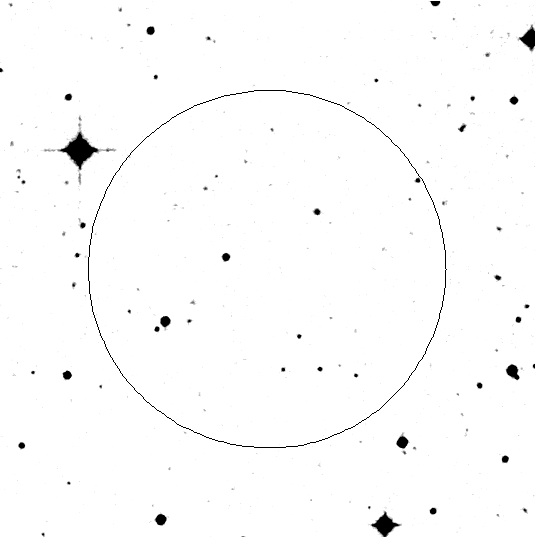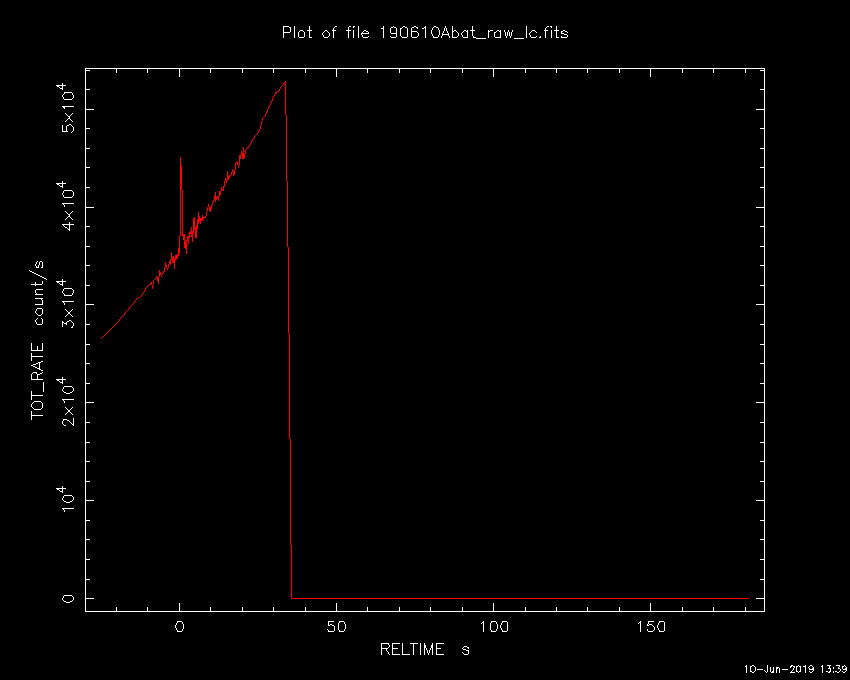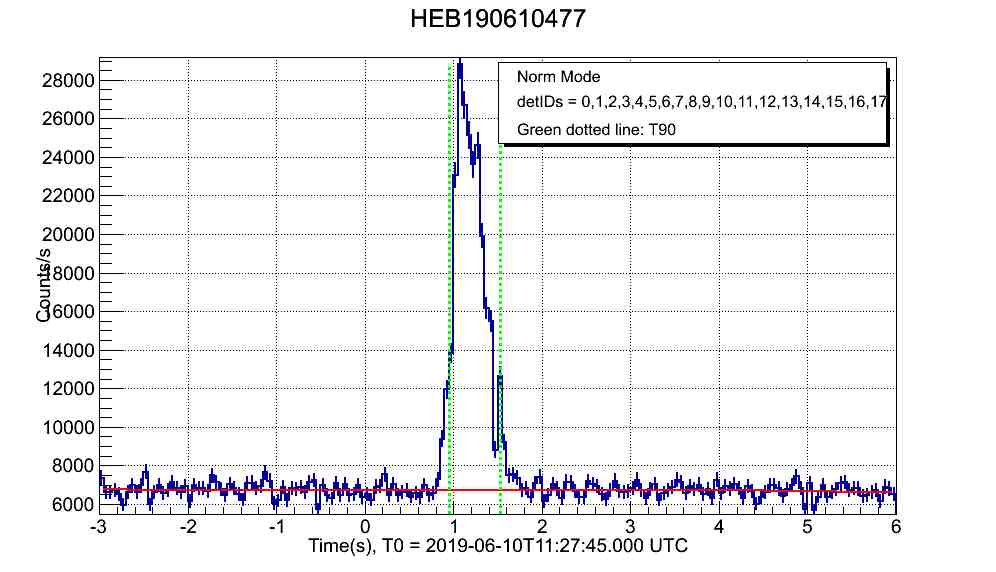- GCN/BACODINE POSITION NOTICE
TITLE: GCN/SWIFT NOTICE
NOTICE_DATE: Mon 10 Jun 19 11:39:02 UT
NOTICE_TYPE: Swift-BAT GRB Position
TRIGGER_NUM: 907754, Seg_Num: 0
GRB_RA: 46.289d {+03h 05m 09s} (J2000),
46.527d {+03h 06m 07s} (current),
45.675d {+03h 02m 42s} (1950)
GRB_DEC: -7.666d {-07d 39' 57"} (J2000),
-7.591d {-07d 35' 28"} (current),
-7.859d {-07d 51' 33"} (1950)
GRB_ERROR: 3.00 [arcmin radius, statistical only]
GRB_INTEN: 27240 [cnts] Image_Peak=669 [image_cnts]
TRIGGER_DUR: 1.024 [sec]
TRIGGER_INDEX: 155 E_range: 50-350 keV
BKG_INTEN: 158503 [cnts]
BKG_TIME: 41248.94 SOD {11:27:28.94} UT
BKG_DUR: 8 [sec]
GRB_DATE: 18644 TJD; 161 DOY; 19/06/10
GRB_TIME: 41265.71 SOD {11:27:45.71} UT
GRB_PHI: -23.00 [deg]
GRB_THETA: 13.60 [deg]
SOLN_STATUS: 0x20000043
RATE_SIGNIF: 45.86 [sigma]
IMAGE_SIGNIF: 9.91 [sigma]
MERIT_PARAMS: +1 +0 +0 +0 +3 +0 -100 +0 -72 +0
SUN_POSTN: 78.39d {+05h 13m 35s} +23.01d {+23d 00' 26"}
SUN_DIST: 43.68 [deg] Sun_angle= 2.1 [hr] (West of Sun)
MOON_POSTN: 174.95d {+11h 39m 49s} +7.33d {+07d 20' 00"}
MOON_DIST: 128.89 [deg]
MOON_ILLUM: 53 [%]
GAL_COORDS: 187.60,-52.84 [deg] galactic lon,lat of the burst (or transient)
ECL_COORDS: 41.42,-24.04 [deg] ecliptic lon,lat of the burst (or transient)
COMMENTS: SWIFT-BAT GRB Coordinates.
COMMENTS: This Notice was delayed by more than 60 sec past the end of the trigger integration interval;
COMMENTS: probably due to it occurring during a Malindi downlink session.
COMMENTS: This is a rate trigger.
COMMENTS: A point_source was found.
COMMENTS: This does not match any source in the on-board catalog.
COMMENTS: This does not match any source in the ground catalog.
COMMENTS: This is a GRB.
COMMENTS: This trigger occurred during a high background rate interval.
COMMENTS: This trigger occurred at longitude,latitude = 263.70,-13.10 [deg].
COMMENTS:
COMMENTS: NOTE: This BAT event is temporally(1.0<100sec) coincident with the INTEGRAL_SPIACS event (trignum=8295).
- red DSS finding chart
ps-file

- GCN NOTICE
TITLE: GCN/SWIFT NOTICE
NOTICE_DATE: Mon 10 Jun 19 11:39:28 UT
NOTICE_TYPE: Swift-BAT GRB Lightcurve
TRIGGER_NUM: 907754, Seg_Num: 0
GRB_RA: 46.289d {+03h 05m 09s} (J2000),
46.527d {+03h 06m 07s} (current),
45.675d {+03h 02m 42s} (1950)
GRB_DEC: -7.666d {-07d 39' 57"} (J2000),
-7.591d {-07d 35' 28"} (current),
-7.859d {-07d 51' 33"} (1950)
GRB_DATE: 18644 TJD; 161 DOY; 19/06/10
GRB_TIME: 41265.71 SOD {11:27:45.71} UT
TRIGGER_INDEX: 155
GRB_PHI: -23.00 [deg]
GRB_THETA: 13.60 [deg]
DELTA_TIME: -75.00 [sec]
TRIGGER_DUR: 1.024 [sec]
SOLN_STATUS: 0x43
RATE_SIGNIF: 45.86 [sigma]
IMAGE_SIGNIF: 9.91 [sigma]
LC_URL: sw00907754000msb.lc
SUN_POSTN: 78.39d {+05h 13m 35s} +23.01d {+23d 00' 26"}
SUN_DIST: 43.68 [deg] Sun_angle= 2.1 [hr] (West of Sun)
MOON_POSTN: 174.96d {+11h 39m 50s} +7.33d {+07d 19' 55"}
MOON_DIST: 128.90 [deg]
MOON_ILLUM: 53 [%]
GAL_COORDS: 187.60,-52.84 [deg] galactic lon,lat of the burst (or transient)
ECL_COORDS: 41.42,-24.04 [deg] ecliptic lon,lat of the burst (or transient)
COMMENTS: SWIFT-BAT GRB Lightcurve.
COMMENTS:
COMMENTS: The next comments were copied from the BAT_POS Notice:
COMMENTS: This is a rate trigger.
COMMENTS: A point_source was found.
COMMENTS: This does not match any source in the on-board catalog.
COMMENTS: This does not match any source in the ground catalog.
COMMENTS: This is a GRB.
COMMENTS: This trigger occurred during a high background rate interval.
COMMENTS: This trigger occurred at longitude,latitude = 263.70,-13.10 [deg].

- GCN NOTICE
TITLE: GCN/INTEGRAL NOTICE
NOTICE_DATE: Mon 10 Jun 19 11:28:32 UT
NOTICE_TYPE: INTEGRAL SPI ACS Trigger
TRIGGER_NUM: 8295, Sub_Num: 0
GRB_INTEN: 11.93 [sigma]
GRB_TIME: 41264.46 SOD {11:27:44.46} UT
GRB_DATE: 18644 TJD; 161 DOY; 19/06/10
COMMENTS: INTEGRAL SPI_ACS GRB Trigger.
COMMENTS: Time_Scale=2.0000 and Time_Error=1.0000.
COMMENTS:
COMMENTS: NOTE: This SPIACS event is temporally(1.0<100sec) coincident with the CALET_GBM event (trignum=1244201256).
COMMENTS:
COMMENTS: The SPIACS lightcurve can be found at:
COMMENTS: ftp://isdcarc.unige.ch/arc/FTP/ibas/spiacs/2019-06/2019-06-10T11-27-44.3511-06116-11152-0.lc
- GCN Circular #24775
P. A. Evans (U Leicester), J.D. Gropp (PSU), J. A. Kennea (PSU),
N. J. Klingler (PSU), M. J. Moss (GWU), D. M. Palmer (LANL),
B. Sbarufatti (PSU), M. H. Siegel (PSU) and A. Tohuvavohu (PSU) report
on behalf of the Neil Gehrels Swift Observatory Team:
At 11:27:45 UT, the Swift Burst Alert Telescope (BAT) triggered and
located GRB 190610A (trigger=907754). Swift did not slew to
the burst location due to an observing constraint.
The BAT on-board calculated location is
RA, Dec 46.289, -7.666 which is
RA(J2000) = 03h 05m 09s
Dec(J2000) = -07d 39' 57"
with an uncertainty of 3 arcmin (radius, 90% containment, including
systematic uncertainty). The BAT light curve showed a single-peaked
structure with a duration of about 1 sec. This is superimposed
on a rising background rate due to the approach of the SAA.
The peak count rate was ~10,000 counts/sec (15-350 keV),
at ~0 sec after the trigger.
Due to a Sun observing constraint, Swift cannot slew to the BAT
position until 10:44 UT on 2019 June 14. There will thus be no XRT or
UVOT data for this trigger before this time.
Burst Advocate for this burst is P. A. Evans (pae9 AT star.le.ac.uk).
Please contact the BA by email if you require additional information
regarding Swift followup of this burst. In extremely urgent cases, after
trying the Burst Advocate, you can contact the Swift PI by phone (see
Swift TOO web site for information: http://www.swift.psu.edu/)
- GCN Circular #24782
C. Cai, S. Xiao, Q. Luo, Q. B. Yi, C. K. Li,
X. B. Li, G. Li, J. Y. Liao, S. L. Xiong,
C. Z. Liu, X. F. Li, Z. W. Li, Z. Chang, X. F. Lu,
A. M. Zhang, Y. F. Zhang, C. L. Zou (IHEP), Y. J. Jin,
Z. Zhang (THU), T. P. Li (IHEP/THU), F. J. Lu, L. M. Song,
M. Wu, Y. P. Xu, S. N. Zhang (IHEP),
report on behalf of the Insight-HXMT team:
At 2019-06-10T11:27:45.00 (T0), Insight-HXMT/HE detected
GRB 190610A (trigger ID: HEB190610477) in a routine search of the data,
which was also triggered by Swift/BAT (GCN #24775).
The Insight-HXMT/HE light curve mainly consists of a single
pulse with a duration (T90) of 0.56 s measured from T0+0.96 s.
The 1-ms peak rate, measured from T0+1.04 s, is 22407 cnts/sec.
The total counts from this burst is 8510 counts.
URL_LC: http://www.hxmt.org/images/GRB/HEB190610477_lc.jpg
All measurements above are made with the CsI detectors operating in the
regular mode with the energy range of about 80-800 keV (deposited energy).
Only gamma-rays with energy greater than about 200 keV can penetrate
the spacecraft and leave signals in the CsI detectors installed inside
of the telescope.
Insight-HXMT is the first Chinese space X-ray telescope, which was
funded jointly by the China National Space Administration (CNSA) and
the Chinese Academy of Sciences (CAS).
More information about it could be found at:
http://www.hxmt.org.

- GCN Circular #24783
D. M. Palmer (LANL), S. D. Barthelmy (GSFC),
J. R. Cummings (CPI), P. A. Evans (U Leicester),
H. A. Krimm (NSF), A. Y. Lien (GSFC/UMBC),
C. B. Markwardt (GSFC), T. Sakamoto (AGU),
M. Stamatikos (OSU), T. N. Ukwatta (LANL)
(i.e. the Swift-BAT team):
Using the data set from T-240 to T+35 sec from the recent telemetry
downlink,
we report further analysis of BAT GRB 190610A (trigger #907754)
(Evans et al., GCN Circ. 24775). The BAT ground-calculated position is
RA, Dec = 46.244, -7.661 deg which is
RA(J2000) = 03h 04m 58.6s
Dec(J2000) = -07d 39' 38.7"
with an uncertainty of 1.9 arcmin, (radius, sys+stat, 90% containment).
The partial coding was 100%.
The mask-weighted light curve shows a short spike that starts ~T+0.2, peaks
at ~T+0.3, and ends ~T+0.9. Due to the SAA, data beyond ~T+35 s are
unavailable.
T90 (15-350 keV) is 0.62 +- 0.11 sec (estimated error including
systematics).
The time-averaged spectrum from T+0.21 to T+0.89 sec is best fit by a simple
power-law model. The power law index of the time-averaged spectrum is
0.32 +- 0.27. The fluence in the 15-150 keV band is 4.1 +- 0.5 x 10^-7
erg/cm2.
The 1-sec peak photon flux measured from T+0.05 sec in the 15-150 keV band
is 3.9 +- 0.5 ph/cm2/sec. All the quoted errors are at the 90% confidence
level.
The results of the batgrbproduct analysis are available at
http://gcn.gsfc.nasa.gov/notices_s/907754/BA/
- GCN Circular #24805
T. Tamura (Kanagawa U),
A. Yoshida, T. Sakamoto, V. Pal'shin, S. Sugita(AGU),
Y. Kawakubo (LSU), K. Yamaoka (Nagoya U), S. Nakahira (RIKEN),
Y. Asaoka, S. Ozawa, S. Torii (Waseda U), Y. Shimizu (Kanagawa U),
N. Cannady (GSFC/UMBC), M. L. Cherry (LSU),
S. Ricciarini (U of Florence), P. S. Marrocchesi (U of Siena),
and the CALET collaboration:
The short GRB 190610A (Swift-BAT trigger #907754: Evans et al., GCN
Circ. 24775, Palmer et al., GCN Circ. 24783; Insight-HXMT/HE detection:
Cai et al., GCN Circ. 24782) triggered the CALET Gamma-ray Burst Monitor
(CGBM) at 11:27:45.359 UTC on 10 June 2019. The burst signal was seen
by all CGBM detectors.
The burst light curve shows a single pulse which starts at T+0.58 sec,
peaks at T+0.83 sec and ends at T+1.41 sec. The T90 and T50 durations
measured by the SGM data are 0.61 +- 0.16 sec and 0.26 +- 0.05 sec
(40-1000 keV), respectively.
The ground processed light curve is available at
http://cgbm.calet.jp/cgbm_trigger/ground/1244201256/
The CALET data used in this analysis are provided by the Waseda CALET
Operation Center located at the Waseda University.
- GCN Circular #24821
P. A. Evans (U. Leicester) reports on behalf of the Swift team:
Swift has initiated a ToO observation of the Swift/BAT GRB 190610A.
Automated analysis of the XRT data will be presented online at
http://www.swift.ac.uk/ToO_GRBs/00020896
Any uncatalogued X-ray sources detected in this analysis will be
reported on this website and via GCN COUNTERPART notices. These are
not necessarily related to the Swift/BAT event. Any X-ray source
considered to be a probable afterglow candidate will be reported via a
GCN Circular after manual consideration.
Details of the XRT automated analysis methods are detailed in Evans et
al. (2007, A&A, 469, 379; 2009, MNRAS, 397, 1177 and 2014, ApJS, 210, 8).
This circular is an official product of the Swift-XRT team.
- GCN Circular #24828
D. Frederiks, S. Golenetskii, R.Aptekar, A. Kozlova,
A.Lysenko, D. Svinkin, A. Tsvetkova, M. Ulanov, and T. Cline,
on behalf of the Konus-Wind team, report:
The short GRB 190610A
(Swift-BAT detection: Evans et al., GCN 24775;
Insight-HXMT/HE detection: Cai et al., GCN 24782)
triggered Konus-Wind (KW) at T0=41263.560 s UT (11:27:43.560).
The light curve of the burst shows a single, multi-peaked pulse
with a total duration of ~0.6 s.
The emission is seen up to ~10 MeV.
The Konus-Wind light curve of this GRB is available at
http://www.ioffe.ru/LEA/GRBs/GRB190610_T41263/
As observed by Konus-Wind, the burst had
a fluence of (7.65 ± 1.48)x10^-6 erg/cm^2 and
a 16-ms peak energy flux, measured from T0+0.080,
of (2.43 ± 0.31)x10^-5 erg/cm^2/s
(both in the 20 keV - 10 MeV energy range).
The spectrum of the burst (measured from T0 to T0+0.256 s)
is well fitted in the 20 keV - 20 MeV range
by a cutoff power-law (CPL) function with the following model
parameters: the photon index alpha = -0.28(-0.26,+0.33),
and the peak energy Ep = 903(-181,+251) keV, chi2 = 53/47 dof.
Fitting this spectrum with the GRB (Band) function yields
nearly the same alpha and Ep, and an upper limit on beta of -2.3.
All the quoted errors are estimated at the 90% confidence level.
All the presented results are preliminary.
- GCN Circular #24833
A.P. Beardmore (U. Leicester), A. Melandri (INAF-OAB), P. D'Avanzo
(INAF-OAB), M.G. Bernardini (INAF-OAB), J.A. Kennea (PSU), B.
Sbarufatti (INAF-OAB/PSU), J.P. Osborne (U. Leicester) and P.A. Evans
(U. Leicester) report on behalf of the Swift-XRT team:
Swift-XRT has performed follow-up observations of the
Swift/BAT-detected burst GRB 190610A (Palmer et al. GCN Circ. 24783),
collecting 5.0 ks of Photon Counting (PC) mode data between T0+292.3 ks
and T0+300.5 ks.
One uncatalogued X-ray source has been detected consistent with being
within 187 arcsec of the Swift/BAT position, it is below the RASS limit
and shows no definitive signs of fading. Therefore, at the present time
we cannot confirm this as the afterglow. Details of this source are
given below:
Source 7:
RA (J2000.0): 46.2216 = 03:04:53.17
Dec (J2000.0): -7.6824 = -07:40:56.7
Error: 5.3 arcsec (radius, 90% conf. [Enhanced position])
Count-rate: (1.76 [+0.83, -0.64])e-3 ct s^-1
Distance: 111 arcsec from Swift/BAT position.
Flux: (1.17 [+0.55, -0.42])e-13 erg cm^-2 s^-1 (observed, 0.3-10 keV)
We note that the position of this afterglow candidate is consistent
with the galaxy SDSS J030452.77-074055.3 (r=21.5 AB), which has unknown
redshift.
Five uncatalogued sources were also detected too far from the GRB
position to be likely afterglow candidates.
The results of the XRT-team automatic analysis of the XRT observations,
including a position-specific upper limit calculator, are available at
http://www.swift.ac.uk/ToO_GRBs/00020896.
This circular is an official product of the Swift-XRT team.
- GCN Circular #24834
N.P.M. Kuin (UCL/MSSL) and P.A. Evans (Leicester U)
report on behalf of the Swift/UVOT team:
The Swift/UVOT began settled observations of the field of GRB 190610A
292282 s after the BAT trigger (Evans et al., GCN Circ. 24775).
No optical afterglow consistent with the BAT position or the XRT
candidate position (Beardmore et al., GCN Circ. No. 24833) has been
detected in the initial UVOT exposures. Preliminary 3-sigma upper
limits using the UVOT photometric system (Breeveld et al. 2011,
AIP Conf. Proc. 1358, 373) for the initial exposures are:
Filter T_start(s) T_stop(s) Exp(s) Mag
v 292282 300459 4890 >20.3
The magnitudes in the table are not corrected for the Galactic extinction
due to the reddening of E(B-V) = 0.09 in the direction of the burst
(Schlegel et al. 1998).
- GCN Circular #24898
P.A. Evans (U. Leicester) reports on behalf of the Swift-XRT team:
Swift-XRT has carried out further observations of GRB 190610A (Palmer et
al. GCN Circ. 24783, Beardmore et al., GCN Circ. 24883), in order to
ascertain whether the faint source in the BAT error circle ("Source 7")
is fading. Marginal evidence of fading has been detected.
In our later-epoch observations, the source is not detected at the
3-sigma level. The 3-sigma upper limit is 1.27 x 10^-3 ct/sec, or a
1-sigma confidence interval count-rate is 3.2 (+5.6, -1.7) x 10^-4
ct/sec (all rates are 0.3-10 keV). The original detection had a count
rate of 1.76 (+0.83, -0.64) x 10^-3 ct/sec.
Thus the source appears to be fading, but only at the 2.1-sigma level.
Given the low significance of the fading, the faintness of the source,
and the fact that low-level variability is not uncommon among X-ray
sources, we cannot say with confidence that this is definitely the
afterglow of GRB 190610A, however it remains a tantalising possibility.
Due to the faint nature of the object, no further XRT observations are
planned.
The details of the source can be viewed, and the light curve rebinned,
at: http://www.swift.ac.uk/ToO_GRBs/00020896/Source7.php
This circular is an official product of the Swift-XRT team.
![]() Previous IAU Circulars
Previous IAU Circulars 

